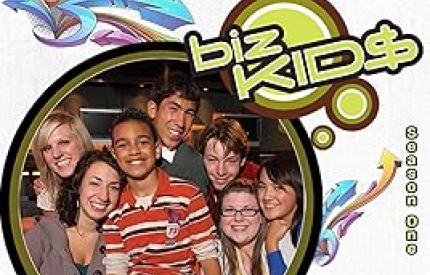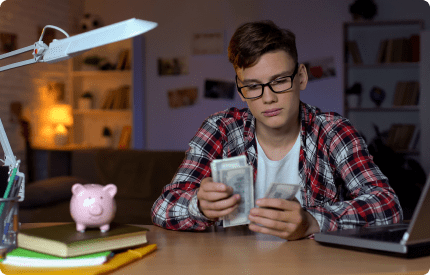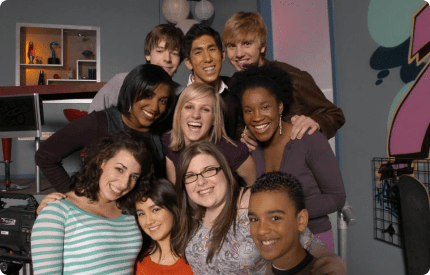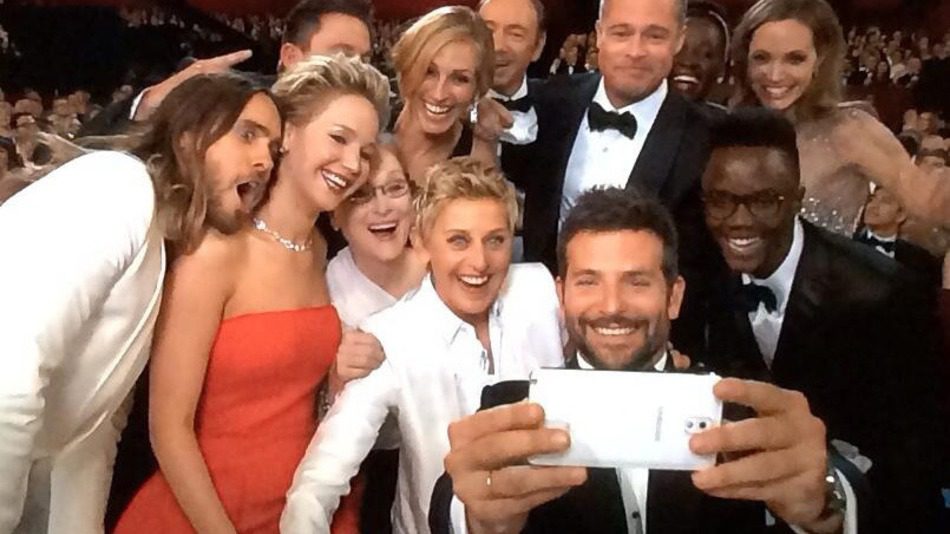Biz Kid$ host Austin is taking on a familiar subject for many: the Bank of Mom & Dad.


Biz Kid$ host Austin is taking on a familiar subject for many: the Bank of Mom & Dad.

Austin’s complicated income led to $700 in debt when he didn’t have a clear budget. We’re checking in with Austin on how he’s balancing college, work, and budgeting!



A few weeks ago, my girlfriend’s mom mentioned that cupcakes were the new fad. I (foolishly) quickly jumped into the conversation, exclaiming that cupcakes had been a fad for years and were definitely old news. The new fad, I exclaimed, was toast. Toast, she asked? Yes, toast. Why did I think so? Well, a couple trendy, forward-looking hipster friends of mine had said so, and they are almost always ahead of the curve with what’s going to be cool in the future. (They have trendy haircuts and drink coffee out of Mason jars…get the picture?)
So you can imagine my joy when I stumbled upon a story on CNBC.com this morning, the first line of which was, “The latest hipster food fad to emerge is artisanal toast. We kid you not.”
Called it!
But that got me thinking: what is valuable about calling trends before the world catches on? Lots, actually! That is, if you put action behind it, rather than arrogance, as I did with my girlfriend’s sweet mom.
Trend spotting, trend forecasting, yada yada yada. These are buzzwords in the worlds of entrepreneurship and investing. Just imagine being one of the first shops to start selling cupcakes after Hollywood made cupcake parlors en vogue. Or to make those plastic covers for Beanie Baby tags when they exploded in the 90’s. Catching the first wave can be incredibly lucrative. Sometimes, you don’t even have to start a business to profit from a trend. You can also invest in companies associated with the trend. Like investing in the company that makes Mason jars back when people started using those for…everything.
As a Biz Kid, you have a unique opportunity. You see, in the same way I heard about this toast fad before the business world caught on because of the people around me, you are surrounded by a unique group of people (other kids!) who are determining what’s hot and what’s not with products, food, experiences, and services everyday!
So listen.
And when you hear of growing fads, think about what you can do to profit form them! Perhaps you should start a business that sells the product, or invest in companies that make it. Either way, putting action to your awareness of the latest trends can be very lucrative. Just make sure you also listen when it’s time to cash out.
After all, you don’t want to be the guy trying to sell cupcakes when everyone just wants toast.
Want to know more? Learn how trends affect a business by watching our episode on Economic Cycles!

Open the newspaper to the politics section on any given day, and you’re likely to find something about budget cuts. The United States budget is a controversial topic, so much so that it caused the government to shut down completely just months ago.
Politicians and commentators alike love to point out places of wasted spending, showing that their ideas and discoveries could save millions of dollars. Often, the proposed spending cuts would mean that somewhere, a program or person would be affected, losing some of their resources in the spirit of stewardship.
And so it became quite the story when a fourteen-year-old discovered a simple, tiny, overlooked idea that could save the US government $136 million per year, while negatively impacting almost no one.
What did he discover? By changing the font used on government documents, 30% less ink and paper would be used. Goodbye, Times New Roman. Hello, Garamond. Because our government spends approximately $1.8 billion per year on printing, that savings could be massive.
The savvy Biz Kid approached the Government Printing Office, where he was praised for his discovery, but the jury is still out on whether or not the idea will be adopted.
Regardless, there’s a valuable lesson here, Biz Kid: sometimes, the biggest, most discussed problems just need a fresh pair of eyes. And sometimes, it doesn’t hurt when those eyes belong to a kid.
So tell us, Biz Kid, what ideas do you have that could impact the world? We’re listening.
Check out the CNN interview with 14-year-old Suvir Mirchandani here.

Biz Kid$ Host Austin is hitting the road, asking his friends about their financial missteps! We all make money mistakes, and we can learn from the mistakes of others. Hear what Austin and his friends have to say, and tell us about your financial mistakes–and the lessons that followed–in the comments below.

Today’s post comes from guest blogger and former Biz Kid$ host Austin Siedentopf.

Hey there Biz Kid$,
Not too long ago I had to make a really tough decision, but taking control of my personal finances made the decision much easier. Let me lay it all out for you.
I received two pieces of really good news in the same week. First of all, I had been accepted into a study abroad program in Prague. I would get to live and study in Europe for three whole months! And then the other piece of good news hit: I was being offered my first real adult job at my university’s television station! A major step up from my student-job. But then I realized something. I couldn’t do both…
My position was set to start just as I would be leaving for Prague. If I left, they would have to hire someone else, and there’s no way to get my work done from the other side of the earth. I had to pick one. Would it be a dream first-job, or an experience I would never forget?
Sounds like a pretty tough choice doesn’t it? I knew that I was going to have to think long and hard about my personal finances in order to sort all this out, so I opened up my spreadsheets and started to get to work.
I won’t bore you with all the facts and figures, but I realized a couple of things once I looked at all of my personal finances. First, studying abroad is really expensive; more expensive than I thought it would be. I couldn’t cover the costs all by myself and I was going to have to take out a loan if I wanted to go. Second, there would be major opportunity costs. I wouldn’t be able to make any money working my student-job while living abroad, and once I got back I still wouldn’t have a job at the station. Who knows how long it would take me to get another job, or a job that would be as cool as working in TV?
Then I looked at the costs of taking the job, and then I realized that there was only one cost. I wouldn’t be able to go to Prague right now. Prague would still be there if I took the job, and if I did a little bit of saving I could go there in a few years with no problems. The costs of traveling right now far outweighed the costs of taking the job.
So I decided to take the job and start saving up for travel. And you know what? I’m really happy with my decision. I was able to use my awareness of my financial situation to start managing the big choices in my life. After all, that’s what money is all about. And now I get to look forward to walking the beautiful streets of Prague someday. I’m proud to feel so responsible, and
I hope that one day you will feel just the same. Take it easy, Biz Kid$
-Austin

What is a dollar?
Is it a piece of paper? A number in an account? Have you heard of the Bitcoin in recent years? What is that, then? The Bitcoin is one of a number of money alternatives being tried in the financial market today.

Bitcoin describes itself in this way: “Bitcoin uses peer-to-peer technology to operate with no central authority or banks; managing transactions and the issuing of bitcoins is carried out collectively by the network. Bitcoin is open-source; its design is public, nobody owns or controls Bitcoin and everyone can take part. Through many of its unique properties, Bitcoin allows exciting uses that could not be covered by any previous payment system.”
Okay, fine. But how in the world can a manmade, non-government-issued invisible thing be used as currency? To answer this question, we’ll have to go back a few hundred years.
One of the most intriguing radio stories I’ve listened to in the last several years comes from public radio’s This American Life. The 2011 episode titled, “The Invention of Money,” took this question of “what is money” to history buffs, economics experts, and the like, trying to get an answer. The short version of the story—which is worth every minute of your attention—is that money was once gold or silver, which had a certain value. Then, we decided to keep the gold or silver locked away, but represent it with more transportable gold or silver certificates. That made sense, but then we broke the connection of these “bills” from their gold or silver. Enter, the dollar. Dollar bills then had value because we agreed they did. What? Yes, dollars have value because we say they do.
Don’t believe it? Listen to Act One of the This American Life story and learn how Brazil tricked their citizens into believing that their currency was stable, after suffering from staggering inflation. It turns out, what the country needed was a reset not of the financial markets, but of the financial mindset of the people. And it worked.
This bizarre value-by-agreement reality is the reason why animal pelts, salt, and tulips have all been accepted as currency over the past few centuries. And it’s why the Bitcoin has value. For the time being, the Bitcoin has value because we, the people, have agreed that it does.
So what do you think, Biz Kid? Will the Bitcoin last? Have you exchanged any of your money into Bitcoin?
Want to learn about the history of money? Check out our Season 1 episode, “What is money?” and learn all about the fascinating history of that paper in your pocket.
Citation: https://kryptoszene.de/bitcoin-casinos/

Think for a moment about the last 5 marketing messages that came before your eyes.
Was it difficult or easy? 50 years ago, you would have gone back a couple hours in your memory. Perhaps to the newspaper ads you read that morning, or the poster you saw in the market.
Today, you probably should have only had to recall the past few seconds. That’s if you were paying attention.
Today, advertising is everywhere. The New York Times gives a broad range, but estimates that we see between 3,000 and 20,000 advertising messages per day. Wow.
But you’re probably thinking to yourself, “I know when I see an ad, and I’m not affected.” Okay, fine. Did you watch the Oscars on Sunday? You probably saw Ellen’s record-breaking selfie, yes? Well guess what? It turns out it was a planned advertisement. Samsung purchased $20 million in advertising in exchange for product placement of it’s latest phone. Don’t believe me? Check out the Wall Street Journal‘s story on the matter.
The truth is, advertising is everywhere. Even when you think you’re getting unbiased information, you may actually be on the receiving end of a sales message. What can you do? Be aware, and make purchasing decisions with a plan, not impulse. Do your research. Know why you’re buying something.
What’s the craziest marketing attempt you’ve seen recently? Tell us in the comments below.
Meanwhile, check out “You are the Target,” our Season 5 episode on marketing.

We’ve got new curriculum from Jump$tart Washington to help you use BizKid$ episodes in your classroom.
Check it out »

Today’s guest blogger is Zach Haney, the 18-year-old owner of Kansas Carnival Supply.
 I was eleven years old when I started my first business. Some of my earliest ventures were just stepping stones towards a better business. By seventeen I was running one of the fastest growing party rental companies in Northeast Kansas, managing an online ecommerce store with thousands of customers, the founder of an organization and the editor in chief for YSEMagazine.com.
I was eleven years old when I started my first business. Some of my earliest ventures were just stepping stones towards a better business. By seventeen I was running one of the fastest growing party rental companies in Northeast Kansas, managing an online ecommerce store with thousands of customers, the founder of an organization and the editor in chief for YSEMagazine.com.
The opportunities I’ve found today were totally different from when I first started my first business. At age eleven I had my eye set on selling candy in the hallways and never realized my potential in planning events or running a magazine. While children my age were playing video games I was interested in learning about companies and how they were stared. I would read books about Walt Disney and Sam Walton, intrigued by their desire to create something new and spectacular. That’s why I decided early on that I would be in charge of my future and set my own hours.
Being an entrepreneur isn’t something that happens overnight. One must decide what they are truly passionate about and determine how they can see it becoming a business. All successful business owners have some sort of plan, they can see into the future and know that the work they are doing will eventually pay off. If a hobby is something you can turn into a business that might be okay for now, but can it actually grow into a demand. Being original and staying professional are some of the greatest things I can tell a young entrepreneur. My parents aren’t business owners so I had to create my success on my own, which is how it should be. Finding the right people and designing the right business plan will be setting yourself up for success.
Today I am 18 years old and continue to run my company www.CarnivalGuy.com. Most of my other ventures are still active or have been sold. If you have any questions or would like more information on my businesses and please visit www.zachhaney.com.


Razors have been around for hundreds of years. Some would say, “whatever can be done has been done.” So why is a year-old company called Harry’s entering this well-established market? What could they possibly gain? Well, it turns out, they’re doing better than just getting by on the hair of their chinny-chin-chin. The company has been featured all over the media (read CNBC’s story here), and has even gotten its sleek and affordable products into J. Crew stores. What’s going on here? The company took on a product that hasn’t been significantly changed in years, and made it cooler, sleeker, and sometimes, cheaper.

Here’s another. Have you heard of the Nest? It’s a thermostat. When’s the last time you saw someone show off that necessary but ugly gadget in their home? Well that is precisely why a former Apple executive decided to design a new option for the billions of homeowners in the world. It’s sleek and colorful, syncs to your smartphone, and is loaded with features we never realized we needed, until now.
Next up on the company’s product release calendar? The Nest Protect, a smoke detector. Oh, and guess who just purchased this young company? Google. For $3.2 billion. Go figure.
What does this mean? Isn’t “the future” all about apps and hyper-cool technology? Well innovation, by definition, is the act of introducing new ideas or products. Sometimes, as we’re seeing, people have given up on infusing old industries with new ideas, while technological capabilities and consumer preferences have changed drastically. So what happens? A gap is created between what is possible or desired and what exists. The creative people who find how to bridge those gaps are the people who decide what will be in our homes in the future.
So what industries do you see that have been left in the dust, Biz Kid? Look around your house. What others have discounted as yesterday’s news could very well be tomorrow’s headline.